Self-Healing Concrete: Future Applications in Civil Engineering
VerifiedAdded on 2023/03/30
|47
|14884
|105
Thesis and Dissertation
AI Summary
This dissertation provides a comprehensive analysis of self-healing concrete, exploring its significance, mechanisms, and applications in civil engineering. It begins with an introduction to concrete's limitations, particularly its susceptibility to cracking, and introduces self-healing concrete as a potential solution. The research delves into the rationale and significance of studying self-healing concrete, highlighting its potential to reduce maintenance costs and enhance structural durability. The aim of the research is to understand the importance of self-healing concrete and its applications in the future of civil engineering. The literature review covers the importance of self-healing concrete, its mechanisms, and its effectiveness, while also considering cost-benefit analysis and sustainability. The research methodology employs an inductive approach, utilizing secondary qualitative data and interpretivism philosophy. The data analysis section presents thematic analysis, and the dissertation concludes with recommendations for future research and practical implementation of self-healing concrete in civil engineering projects. The study acknowledges that while current applications are limited and production costs are high, ongoing research aims to improve its effectiveness under various environmental conditions.
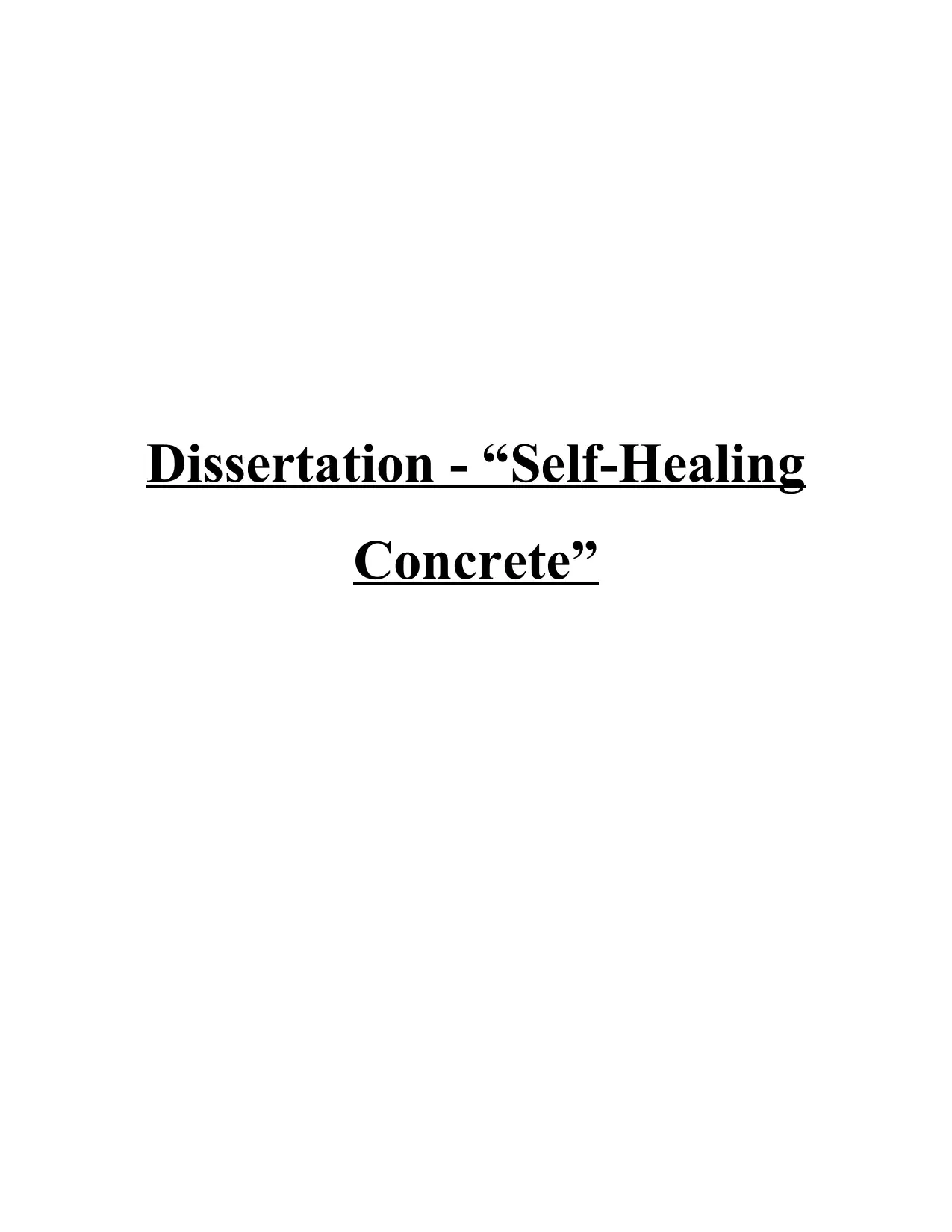
Dissertation - “Self-Healing
Concrete”
Concrete”
Paraphrase This Document
Need a fresh take? Get an instant paraphrase of this document with our AI Paraphraser

ACKNOWLEDGEMENT
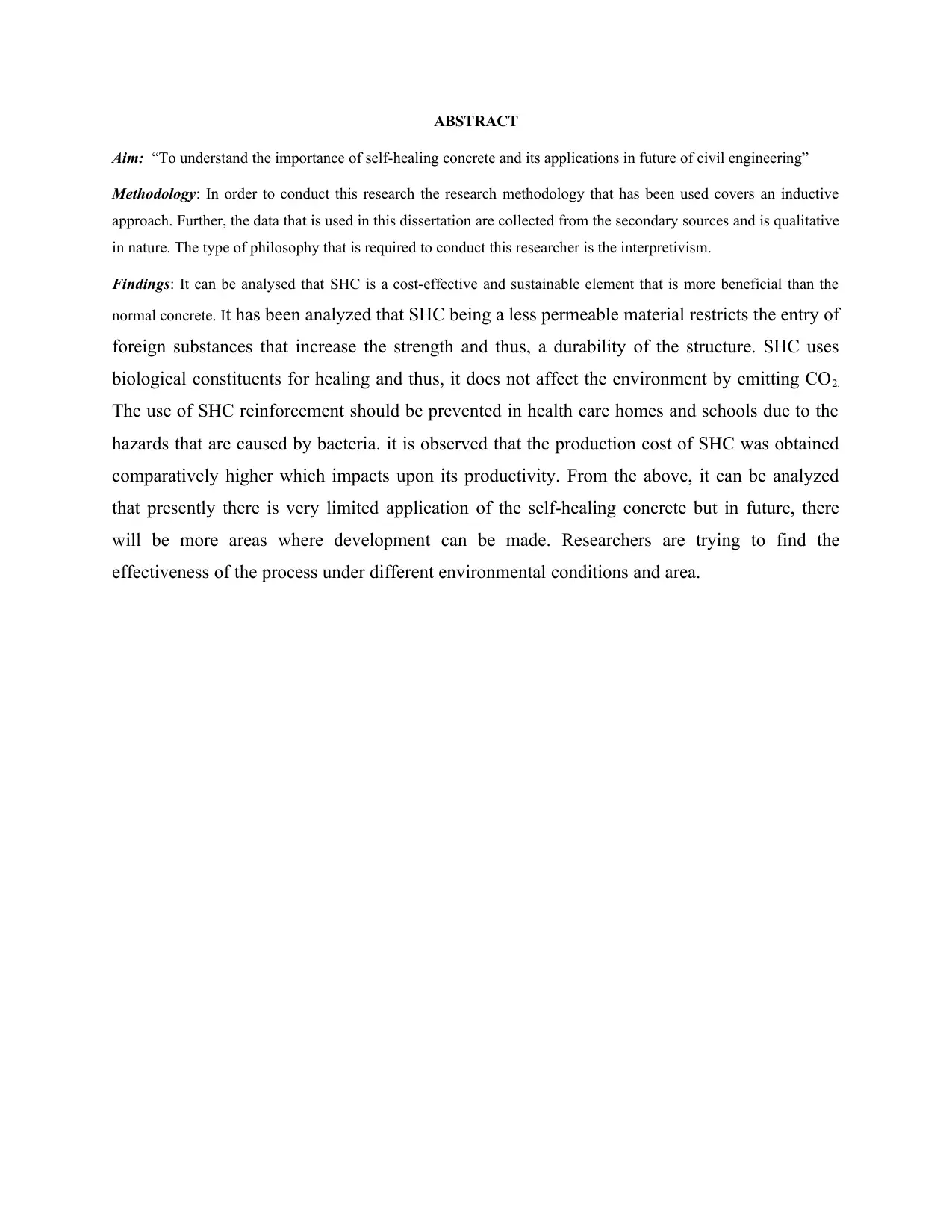
ABSTRACT
Aim: “To understand the importance of self-healing concrete and its applications in future of civil engineering”
Methodology: In order to conduct this research the research methodology that has been used covers an inductive
approach. Further, the data that is used in this dissertation are collected from the secondary sources and is qualitative
in nature. The type of philosophy that is required to conduct this researcher is the interpretivism.
Findings: It can be analysed that SHC is a cost-effective and sustainable element that is more beneficial than the
normal concrete. It has been analyzed that SHC being a less permeable material restricts the entry of
foreign substances that increase the strength and thus, a durability of the structure. SHC uses
biological constituents for healing and thus, it does not affect the environment by emitting CO2.
The use of SHC reinforcement should be prevented in health care homes and schools due to the
hazards that are caused by bacteria. it is observed that the production cost of SHC was obtained
comparatively higher which impacts upon its productivity. From the above, it can be analyzed
that presently there is very limited application of the self-healing concrete but in future, there
will be more areas where development can be made. Researchers are trying to find the
effectiveness of the process under different environmental conditions and area.
Aim: “To understand the importance of self-healing concrete and its applications in future of civil engineering”
Methodology: In order to conduct this research the research methodology that has been used covers an inductive
approach. Further, the data that is used in this dissertation are collected from the secondary sources and is qualitative
in nature. The type of philosophy that is required to conduct this researcher is the interpretivism.
Findings: It can be analysed that SHC is a cost-effective and sustainable element that is more beneficial than the
normal concrete. It has been analyzed that SHC being a less permeable material restricts the entry of
foreign substances that increase the strength and thus, a durability of the structure. SHC uses
biological constituents for healing and thus, it does not affect the environment by emitting CO2.
The use of SHC reinforcement should be prevented in health care homes and schools due to the
hazards that are caused by bacteria. it is observed that the production cost of SHC was obtained
comparatively higher which impacts upon its productivity. From the above, it can be analyzed
that presently there is very limited application of the self-healing concrete but in future, there
will be more areas where development can be made. Researchers are trying to find the
effectiveness of the process under different environmental conditions and area.
⊘ This is a preview!⊘
Do you want full access?
Subscribe today to unlock all pages.

Trusted by 1+ million students worldwide
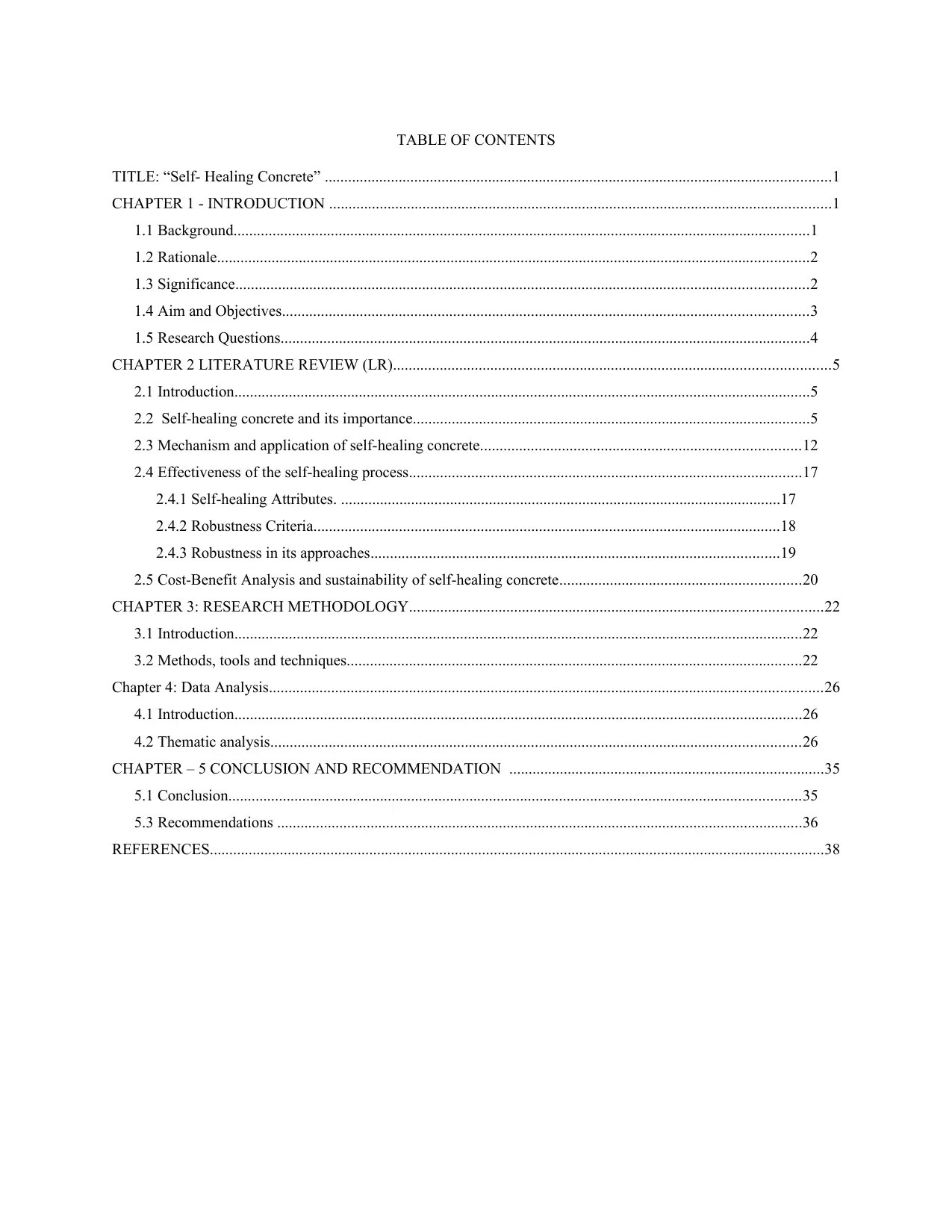
TABLE OF CONTENTS
TITLE: “Self- Healing Concrete” ..................................................................................................................................1
CHAPTER 1 - INTRODUCTION .................................................................................................................................1
1.1 Background....................................................................................................................................................1
1.2 Rationale........................................................................................................................................................2
1.3 Significance...................................................................................................................................................2
1.4 Aim and Objectives.......................................................................................................................................3
1.5 Research Questions........................................................................................................................................4
CHAPTER 2 LITERATURE REVIEW (LR)................................................................................................................5
2.1 Introduction....................................................................................................................................................5
2.2 Self-healing concrete and its importance......................................................................................................5
2.3 Mechanism and application of self-healing concrete..................................................................................12
2.4 Effectiveness of the self-healing process.....................................................................................................17
2.4.1 Self-healing Attributes. .................................................................................................................17
2.4.2 Robustness Criteria........................................................................................................................18
2.4.3 Robustness in its approaches.........................................................................................................19
2.5 Cost-Benefit Analysis and sustainability of self-healing concrete..............................................................20
CHAPTER 3: RESEARCH METHODOLOGY..........................................................................................................22
3.1 Introduction..................................................................................................................................................22
3.2 Methods, tools and techniques.....................................................................................................................22
Chapter 4: Data Analysis..............................................................................................................................................26
4.1 Introduction..................................................................................................................................................26
4.2 Thematic analysis........................................................................................................................................26
CHAPTER – 5 CONCLUSION AND RECOMMENDATION .................................................................................35
5.1 Conclusion...................................................................................................................................................35
5.3 Recommendations .......................................................................................................................................36
REFERENCES..............................................................................................................................................................38
TITLE: “Self- Healing Concrete” ..................................................................................................................................1
CHAPTER 1 - INTRODUCTION .................................................................................................................................1
1.1 Background....................................................................................................................................................1
1.2 Rationale........................................................................................................................................................2
1.3 Significance...................................................................................................................................................2
1.4 Aim and Objectives.......................................................................................................................................3
1.5 Research Questions........................................................................................................................................4
CHAPTER 2 LITERATURE REVIEW (LR)................................................................................................................5
2.1 Introduction....................................................................................................................................................5
2.2 Self-healing concrete and its importance......................................................................................................5
2.3 Mechanism and application of self-healing concrete..................................................................................12
2.4 Effectiveness of the self-healing process.....................................................................................................17
2.4.1 Self-healing Attributes. .................................................................................................................17
2.4.2 Robustness Criteria........................................................................................................................18
2.4.3 Robustness in its approaches.........................................................................................................19
2.5 Cost-Benefit Analysis and sustainability of self-healing concrete..............................................................20
CHAPTER 3: RESEARCH METHODOLOGY..........................................................................................................22
3.1 Introduction..................................................................................................................................................22
3.2 Methods, tools and techniques.....................................................................................................................22
Chapter 4: Data Analysis..............................................................................................................................................26
4.1 Introduction..................................................................................................................................................26
4.2 Thematic analysis........................................................................................................................................26
CHAPTER – 5 CONCLUSION AND RECOMMENDATION .................................................................................35
5.1 Conclusion...................................................................................................................................................35
5.3 Recommendations .......................................................................................................................................36
REFERENCES..............................................................................................................................................................38
Paraphrase This Document
Need a fresh take? Get an instant paraphrase of this document with our AI Paraphraser
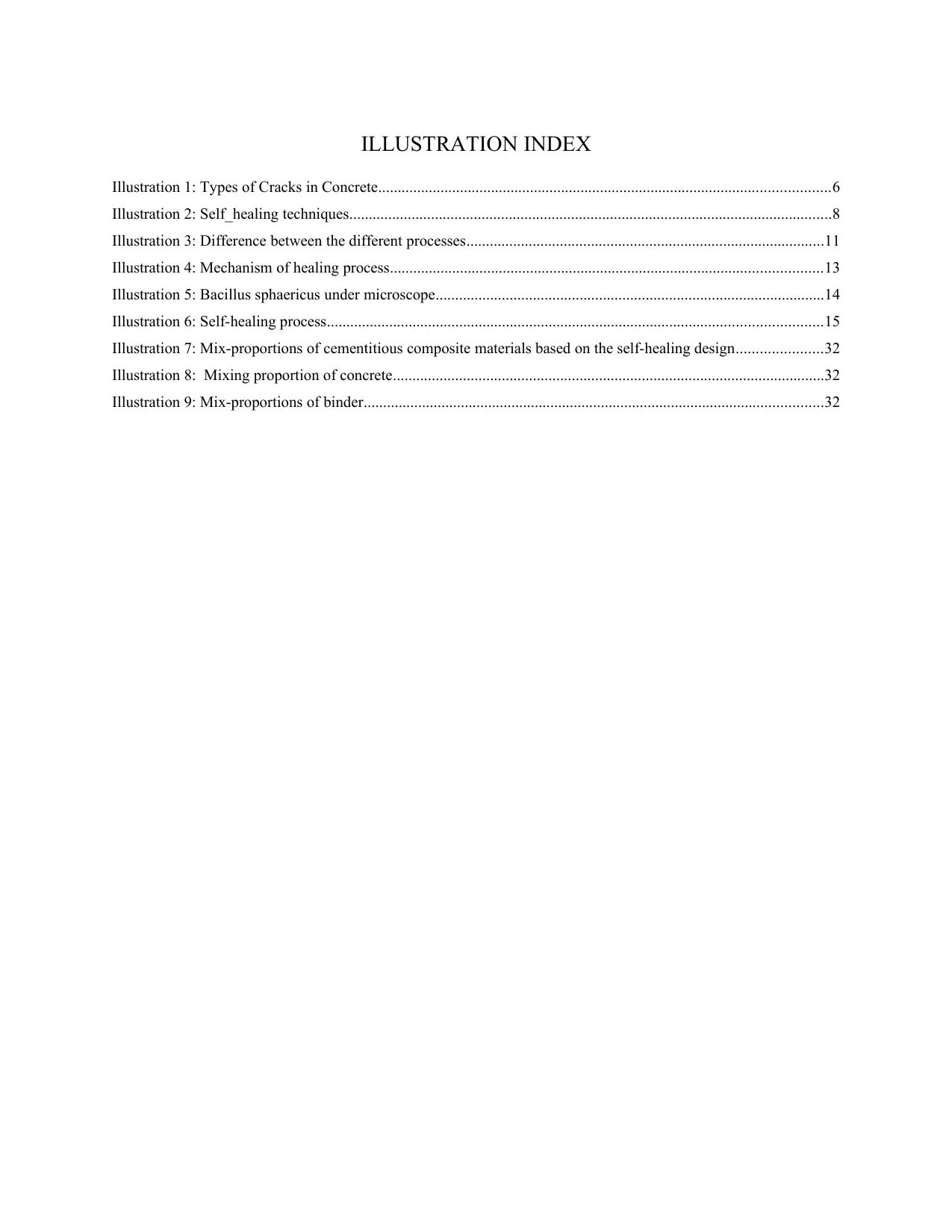
ILLUSTRATION INDEX
Illustration 1: Types of Cracks in Concrete....................................................................................................................6
Illustration 2: Self_healing techniques............................................................................................................................8
Illustration 3: Difference between the different processes............................................................................................11
Illustration 4: Mechanism of healing process...............................................................................................................13
Illustration 5: Bacillus sphaericus under microscope....................................................................................................14
Illustration 6: Self-healing process...............................................................................................................................15
Illustration 7: Mix-proportions of cementitious composite materials based on the self-healing design......................32
Illustration 8: Mixing proportion of concrete...............................................................................................................32
Illustration 9: Mix-proportions of binder......................................................................................................................32
Illustration 1: Types of Cracks in Concrete....................................................................................................................6
Illustration 2: Self_healing techniques............................................................................................................................8
Illustration 3: Difference between the different processes............................................................................................11
Illustration 4: Mechanism of healing process...............................................................................................................13
Illustration 5: Bacillus sphaericus under microscope....................................................................................................14
Illustration 6: Self-healing process...............................................................................................................................15
Illustration 7: Mix-proportions of cementitious composite materials based on the self-healing design......................32
Illustration 8: Mixing proportion of concrete...............................................................................................................32
Illustration 9: Mix-proportions of binder......................................................................................................................32
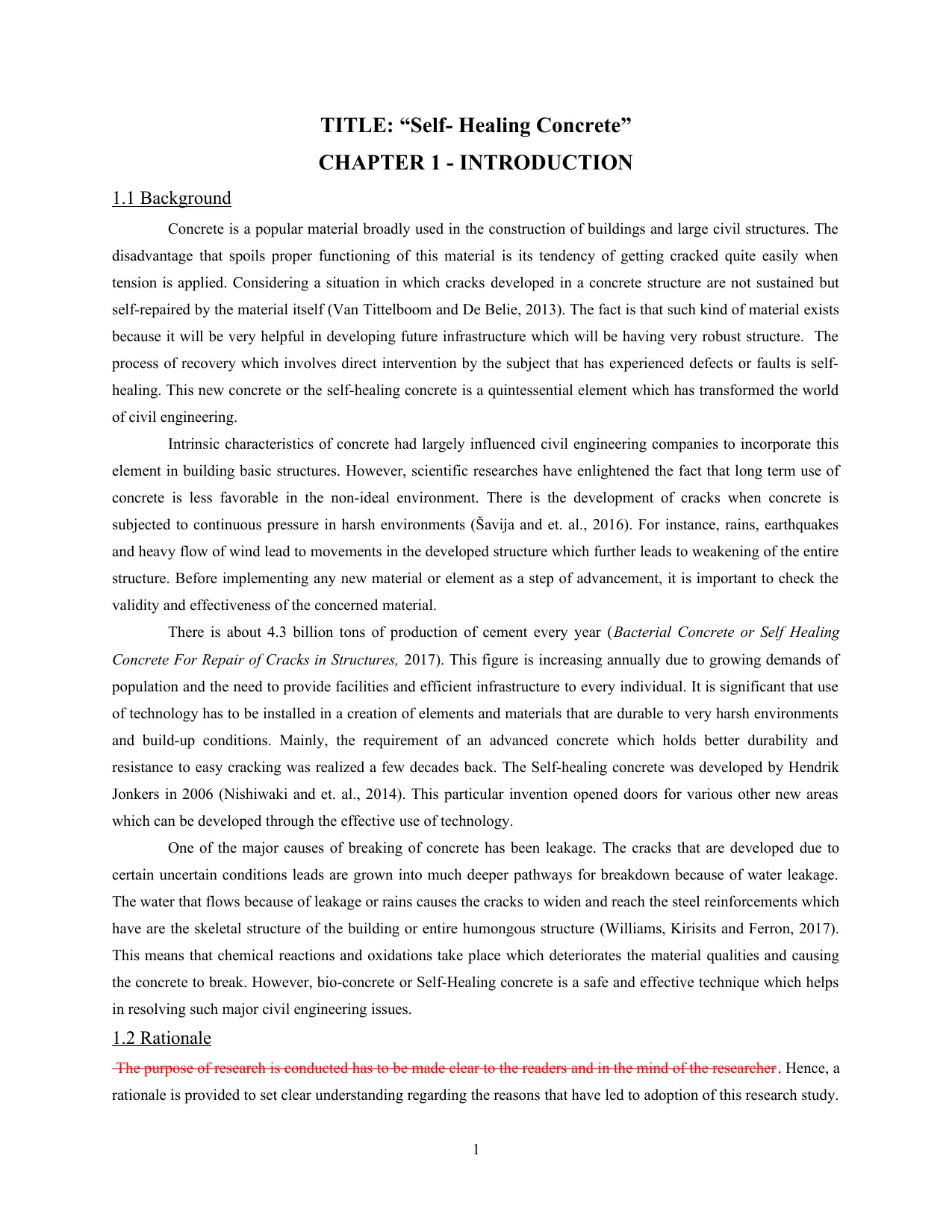
TITLE: “Self- Healing Concrete”
CHAPTER 1 - INTRODUCTION
1.1 Background
Concrete is a popular material broadly used in the construction of buildings and large civil structures. The
disadvantage that spoils proper functioning of this material is its tendency of getting cracked quite easily when
tension is applied. Considering a situation in which cracks developed in a concrete structure are not sustained but
self-repaired by the material itself (Van Tittelboom and De Belie, 2013). The fact is that such kind of material exists
because it will be very helpful in developing future infrastructure which will be having very robust structure. The
process of recovery which involves direct intervention by the subject that has experienced defects or faults is self-
healing. This new concrete or the self-healing concrete is a quintessential element which has transformed the world
of civil engineering.
Intrinsic characteristics of concrete had largely influenced civil engineering companies to incorporate this
element in building basic structures. However, scientific researches have enlightened the fact that long term use of
concrete is less favorable in the non-ideal environment. There is the development of cracks when concrete is
subjected to continuous pressure in harsh environments (Šavija and et. al., 2016). For instance, rains, earthquakes
and heavy flow of wind lead to movements in the developed structure which further leads to weakening of the entire
structure. Before implementing any new material or element as a step of advancement, it is important to check the
validity and effectiveness of the concerned material.
There is about 4.3 billion tons of production of cement every year (Bacterial Concrete or Self Healing
Concrete For Repair of Cracks in Structures, 2017). This figure is increasing annually due to growing demands of
population and the need to provide facilities and efficient infrastructure to every individual. It is significant that use
of technology has to be installed in a creation of elements and materials that are durable to very harsh environments
and build-up conditions. Mainly, the requirement of an advanced concrete which holds better durability and
resistance to easy cracking was realized a few decades back. The Self-healing concrete was developed by Hendrik
Jonkers in 2006 (Nishiwaki and et. al., 2014). This particular invention opened doors for various other new areas
which can be developed through the effective use of technology.
One of the major causes of breaking of concrete has been leakage. The cracks that are developed due to
certain uncertain conditions leads are grown into much deeper pathways for breakdown because of water leakage.
The water that flows because of leakage or rains causes the cracks to widen and reach the steel reinforcements which
have are the skeletal structure of the building or entire humongous structure (Williams, Kirisits and Ferron, 2017).
This means that chemical reactions and oxidations take place which deteriorates the material qualities and causing
the concrete to break. However, bio-concrete or Self-Healing concrete is a safe and effective technique which helps
in resolving such major civil engineering issues.
1.2 Rationale
The purpose of research is conducted has to be made clear to the readers and in the mind of the researcher . Hence, a
rationale is provided to set clear understanding regarding the reasons that have led to adoption of this research study.
1
CHAPTER 1 - INTRODUCTION
1.1 Background
Concrete is a popular material broadly used in the construction of buildings and large civil structures. The
disadvantage that spoils proper functioning of this material is its tendency of getting cracked quite easily when
tension is applied. Considering a situation in which cracks developed in a concrete structure are not sustained but
self-repaired by the material itself (Van Tittelboom and De Belie, 2013). The fact is that such kind of material exists
because it will be very helpful in developing future infrastructure which will be having very robust structure. The
process of recovery which involves direct intervention by the subject that has experienced defects or faults is self-
healing. This new concrete or the self-healing concrete is a quintessential element which has transformed the world
of civil engineering.
Intrinsic characteristics of concrete had largely influenced civil engineering companies to incorporate this
element in building basic structures. However, scientific researches have enlightened the fact that long term use of
concrete is less favorable in the non-ideal environment. There is the development of cracks when concrete is
subjected to continuous pressure in harsh environments (Šavija and et. al., 2016). For instance, rains, earthquakes
and heavy flow of wind lead to movements in the developed structure which further leads to weakening of the entire
structure. Before implementing any new material or element as a step of advancement, it is important to check the
validity and effectiveness of the concerned material.
There is about 4.3 billion tons of production of cement every year (Bacterial Concrete or Self Healing
Concrete For Repair of Cracks in Structures, 2017). This figure is increasing annually due to growing demands of
population and the need to provide facilities and efficient infrastructure to every individual. It is significant that use
of technology has to be installed in a creation of elements and materials that are durable to very harsh environments
and build-up conditions. Mainly, the requirement of an advanced concrete which holds better durability and
resistance to easy cracking was realized a few decades back. The Self-healing concrete was developed by Hendrik
Jonkers in 2006 (Nishiwaki and et. al., 2014). This particular invention opened doors for various other new areas
which can be developed through the effective use of technology.
One of the major causes of breaking of concrete has been leakage. The cracks that are developed due to
certain uncertain conditions leads are grown into much deeper pathways for breakdown because of water leakage.
The water that flows because of leakage or rains causes the cracks to widen and reach the steel reinforcements which
have are the skeletal structure of the building or entire humongous structure (Williams, Kirisits and Ferron, 2017).
This means that chemical reactions and oxidations take place which deteriorates the material qualities and causing
the concrete to break. However, bio-concrete or Self-Healing concrete is a safe and effective technique which helps
in resolving such major civil engineering issues.
1.2 Rationale
The purpose of research is conducted has to be made clear to the readers and in the mind of the researcher . Hence, a
rationale is provided to set clear understanding regarding the reasons that have led to adoption of this research study.
1
⊘ This is a preview!⊘
Do you want full access?
Subscribe today to unlock all pages.

Trusted by 1+ million students worldwide
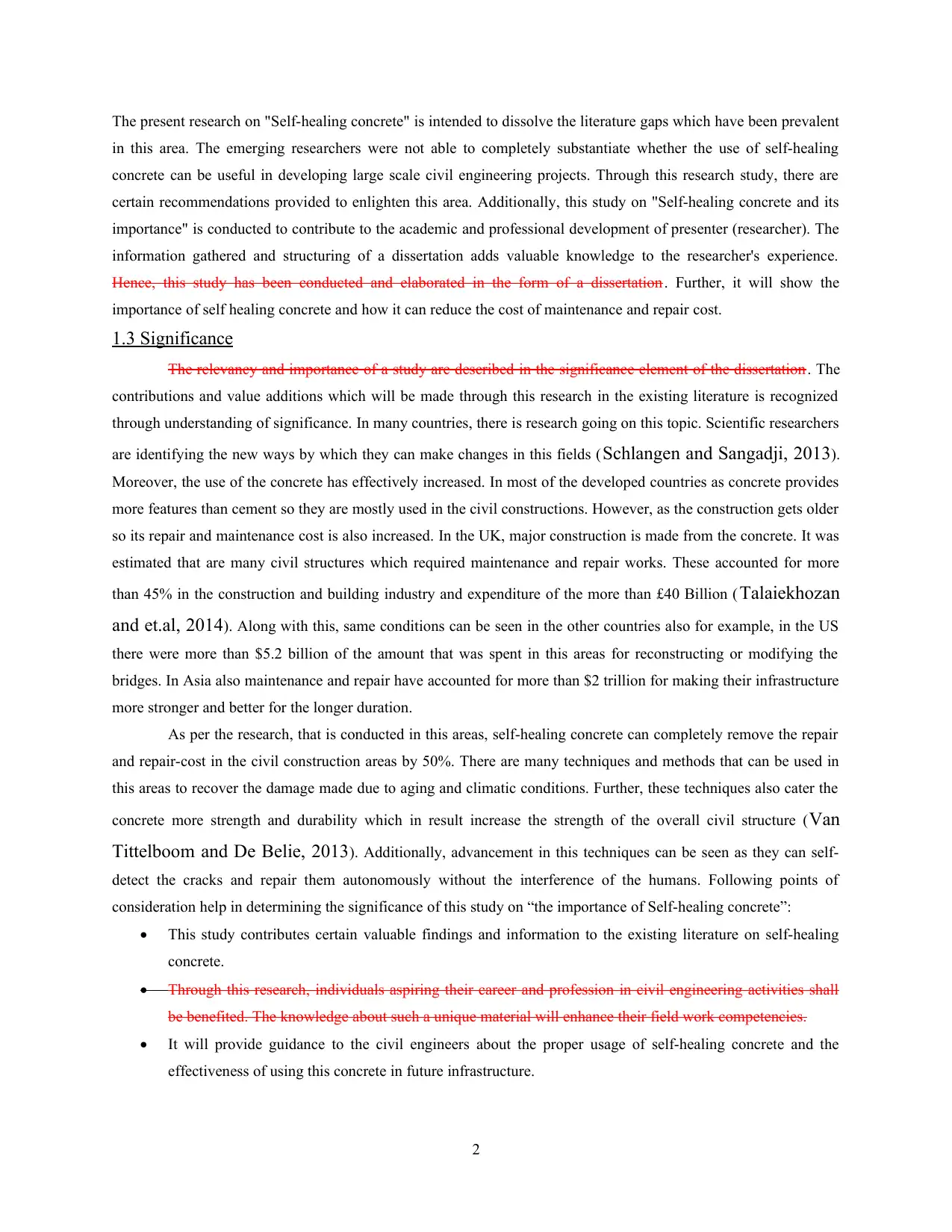
The present research on "Self-healing concrete" is intended to dissolve the literature gaps which have been prevalent
in this area. The emerging researchers were not able to completely substantiate whether the use of self-healing
concrete can be useful in developing large scale civil engineering projects. Through this research study, there are
certain recommendations provided to enlighten this area. Additionally, this study on "Self-healing concrete and its
importance" is conducted to contribute to the academic and professional development of presenter (researcher). The
information gathered and structuring of a dissertation adds valuable knowledge to the researcher's experience.
Hence, this study has been conducted and elaborated in the form of a dissertation . Further, it will show the
importance of self healing concrete and how it can reduce the cost of maintenance and repair cost.
1.3 Significance
The relevancy and importance of a study are described in the significance element of the dissertation . The
contributions and value additions which will be made through this research in the existing literature is recognized
through understanding of significance. In many countries, there is research going on this topic. Scientific researchers
are identifying the new ways by which they can make changes in this fields (Schlangen and Sangadji, 2013).
Moreover, the use of the concrete has effectively increased. In most of the developed countries as concrete provides
more features than cement so they are mostly used in the civil constructions. However, as the construction gets older
so its repair and maintenance cost is also increased. In the UK, major construction is made from the concrete. It was
estimated that are many civil structures which required maintenance and repair works. These accounted for more
than 45% in the construction and building industry and expenditure of the more than £40 Billion ( Talaiekhozan
and et.al, 2014). Along with this, same conditions can be seen in the other countries also for example, in the US
there were more than $5.2 billion of the amount that was spent in this areas for reconstructing or modifying the
bridges. In Asia also maintenance and repair have accounted for more than $2 trillion for making their infrastructure
more stronger and better for the longer duration.
As per the research, that is conducted in this areas, self-healing concrete can completely remove the repair
and repair-cost in the civil construction areas by 50%. There are many techniques and methods that can be used in
this areas to recover the damage made due to aging and climatic conditions. Further, these techniques also cater the
concrete more strength and durability which in result increase the strength of the overall civil structure (Van
Tittelboom and De Belie, 2013). Additionally, advancement in this techniques can be seen as they can self-
detect the cracks and repair them autonomously without the interference of the humans. Following points of
consideration help in determining the significance of this study on “the importance of Self-healing concrete”:
This study contributes certain valuable findings and information to the existing literature on self-healing
concrete.
Through this research, individuals aspiring their career and profession in civil engineering activities shall
be benefited. The knowledge about such a unique material will enhance their field work competencies.
It will provide guidance to the civil engineers about the proper usage of self-healing concrete and the
effectiveness of using this concrete in future infrastructure.
2
in this area. The emerging researchers were not able to completely substantiate whether the use of self-healing
concrete can be useful in developing large scale civil engineering projects. Through this research study, there are
certain recommendations provided to enlighten this area. Additionally, this study on "Self-healing concrete and its
importance" is conducted to contribute to the academic and professional development of presenter (researcher). The
information gathered and structuring of a dissertation adds valuable knowledge to the researcher's experience.
Hence, this study has been conducted and elaborated in the form of a dissertation . Further, it will show the
importance of self healing concrete and how it can reduce the cost of maintenance and repair cost.
1.3 Significance
The relevancy and importance of a study are described in the significance element of the dissertation . The
contributions and value additions which will be made through this research in the existing literature is recognized
through understanding of significance. In many countries, there is research going on this topic. Scientific researchers
are identifying the new ways by which they can make changes in this fields (Schlangen and Sangadji, 2013).
Moreover, the use of the concrete has effectively increased. In most of the developed countries as concrete provides
more features than cement so they are mostly used in the civil constructions. However, as the construction gets older
so its repair and maintenance cost is also increased. In the UK, major construction is made from the concrete. It was
estimated that are many civil structures which required maintenance and repair works. These accounted for more
than 45% in the construction and building industry and expenditure of the more than £40 Billion ( Talaiekhozan
and et.al, 2014). Along with this, same conditions can be seen in the other countries also for example, in the US
there were more than $5.2 billion of the amount that was spent in this areas for reconstructing or modifying the
bridges. In Asia also maintenance and repair have accounted for more than $2 trillion for making their infrastructure
more stronger and better for the longer duration.
As per the research, that is conducted in this areas, self-healing concrete can completely remove the repair
and repair-cost in the civil construction areas by 50%. There are many techniques and methods that can be used in
this areas to recover the damage made due to aging and climatic conditions. Further, these techniques also cater the
concrete more strength and durability which in result increase the strength of the overall civil structure (Van
Tittelboom and De Belie, 2013). Additionally, advancement in this techniques can be seen as they can self-
detect the cracks and repair them autonomously without the interference of the humans. Following points of
consideration help in determining the significance of this study on “the importance of Self-healing concrete”:
This study contributes certain valuable findings and information to the existing literature on self-healing
concrete.
Through this research, individuals aspiring their career and profession in civil engineering activities shall
be benefited. The knowledge about such a unique material will enhance their field work competencies.
It will provide guidance to the civil engineers about the proper usage of self-healing concrete and the
effectiveness of using this concrete in future infrastructure.
2
Paraphrase This Document
Need a fresh take? Get an instant paraphrase of this document with our AI Paraphraser
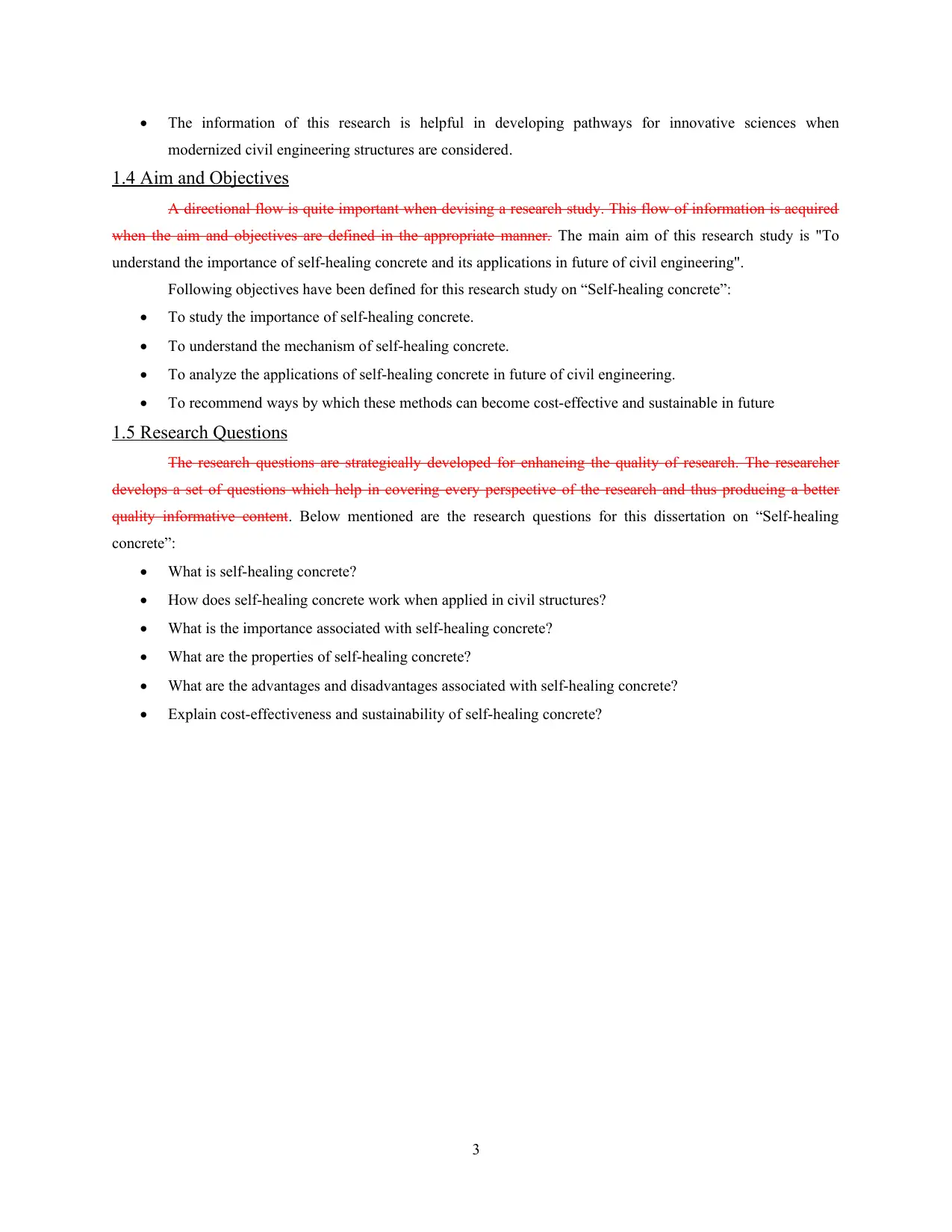
The information of this research is helpful in developing pathways for innovative sciences when
modernized civil engineering structures are considered.
1.4 Aim and Objectives
A directional flow is quite important when devising a research study. This flow of information is acquired
when the aim and objectives are defined in the appropriate manner. The main aim of this research study is "To
understand the importance of self-healing concrete and its applications in future of civil engineering".
Following objectives have been defined for this research study on “Self-healing concrete”:
To study the importance of self-healing concrete.
To understand the mechanism of self-healing concrete.
To analyze the applications of self-healing concrete in future of civil engineering.
To recommend ways by which these methods can become cost-effective and sustainable in future
1.5 Research Questions
The research questions are strategically developed for enhancing the quality of research. The researcher
develops a set of questions which help in covering every perspective of the research and thus producing a better
quality informative content. Below mentioned are the research questions for this dissertation on “Self-healing
concrete”:
What is self-healing concrete?
How does self-healing concrete work when applied in civil structures?
What is the importance associated with self-healing concrete?
What are the properties of self-healing concrete?
What are the advantages and disadvantages associated with self-healing concrete?
Explain cost-effectiveness and sustainability of self-healing concrete?
3
modernized civil engineering structures are considered.
1.4 Aim and Objectives
A directional flow is quite important when devising a research study. This flow of information is acquired
when the aim and objectives are defined in the appropriate manner. The main aim of this research study is "To
understand the importance of self-healing concrete and its applications in future of civil engineering".
Following objectives have been defined for this research study on “Self-healing concrete”:
To study the importance of self-healing concrete.
To understand the mechanism of self-healing concrete.
To analyze the applications of self-healing concrete in future of civil engineering.
To recommend ways by which these methods can become cost-effective and sustainable in future
1.5 Research Questions
The research questions are strategically developed for enhancing the quality of research. The researcher
develops a set of questions which help in covering every perspective of the research and thus producing a better
quality informative content. Below mentioned are the research questions for this dissertation on “Self-healing
concrete”:
What is self-healing concrete?
How does self-healing concrete work when applied in civil structures?
What is the importance associated with self-healing concrete?
What are the properties of self-healing concrete?
What are the advantages and disadvantages associated with self-healing concrete?
Explain cost-effectiveness and sustainability of self-healing concrete?
3
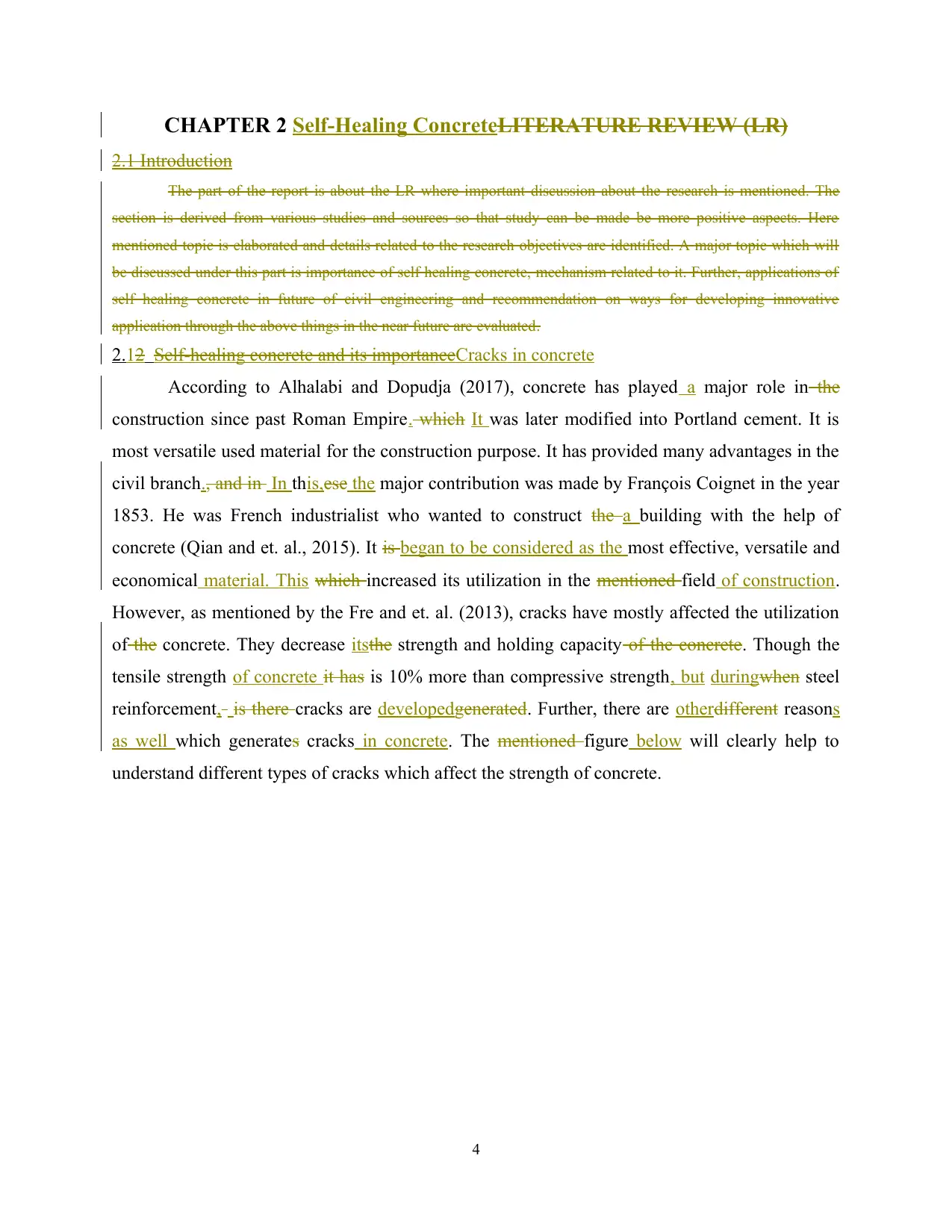
CHAPTER 2 Self-Healing ConcreteLITERATURE REVIEW (LR)
2.1 Introduction
The part of the report is about the LR where important discussion about the research is mentioned. The
section is derived from various studies and sources so that study can be made be more positive aspects. Here
mentioned topic is elaborated and details related to the research objectives are identified. A major topic which will
be discussed under this part is importance of self healing concrete, mechanism related to it. Further, applications of
self healing concrete in future of civil engineering and recommendation on ways for developing innovative
application through the above things in the near future are evaluated.
2.12 Self-healing concrete and its importanceCracks in concrete
According to Alhalabi and Dopudja (2017), concrete has played a major role in the
construction since past Roman Empire. which It was later modified into Portland cement. It is
most versatile used material for the construction purpose. It has provided many advantages in the
civil branch., and in In this,ese the major contribution was made by François Coignet in the year
1853. He was French industrialist who wanted to construct the a building with the help of
concrete (Qian and et. al., 2015). It is began to be considered as the most effective, versatile and
economical material. This which increased its utilization in the mentioned field of construction.
However, as mentioned by the Fre and et. al. (2013), cracks have mostly affected the utilization
of the concrete. They decrease itsthe strength and holding capacity of the concrete. Though the
tensile strength of concrete it has is 10% more than compressive strength, but duringwhen steel
reinforcement, is there cracks are developedgenerated. Further, there are otherdifferent reasons
as well which generates cracks in concrete. The mentioned figure below will clearly help to
understand different types of cracks which affect the strength of concrete.
4
2.1 Introduction
The part of the report is about the LR where important discussion about the research is mentioned. The
section is derived from various studies and sources so that study can be made be more positive aspects. Here
mentioned topic is elaborated and details related to the research objectives are identified. A major topic which will
be discussed under this part is importance of self healing concrete, mechanism related to it. Further, applications of
self healing concrete in future of civil engineering and recommendation on ways for developing innovative
application through the above things in the near future are evaluated.
2.12 Self-healing concrete and its importanceCracks in concrete
According to Alhalabi and Dopudja (2017), concrete has played a major role in the
construction since past Roman Empire. which It was later modified into Portland cement. It is
most versatile used material for the construction purpose. It has provided many advantages in the
civil branch., and in In this,ese the major contribution was made by François Coignet in the year
1853. He was French industrialist who wanted to construct the a building with the help of
concrete (Qian and et. al., 2015). It is began to be considered as the most effective, versatile and
economical material. This which increased its utilization in the mentioned field of construction.
However, as mentioned by the Fre and et. al. (2013), cracks have mostly affected the utilization
of the concrete. They decrease itsthe strength and holding capacity of the concrete. Though the
tensile strength of concrete it has is 10% more than compressive strength, but duringwhen steel
reinforcement, is there cracks are developedgenerated. Further, there are otherdifferent reasons
as well which generates cracks in concrete. The mentioned figure below will clearly help to
understand different types of cracks which affect the strength of concrete.
4
⊘ This is a preview!⊘
Do you want full access?
Subscribe today to unlock all pages.

Trusted by 1+ million students worldwide
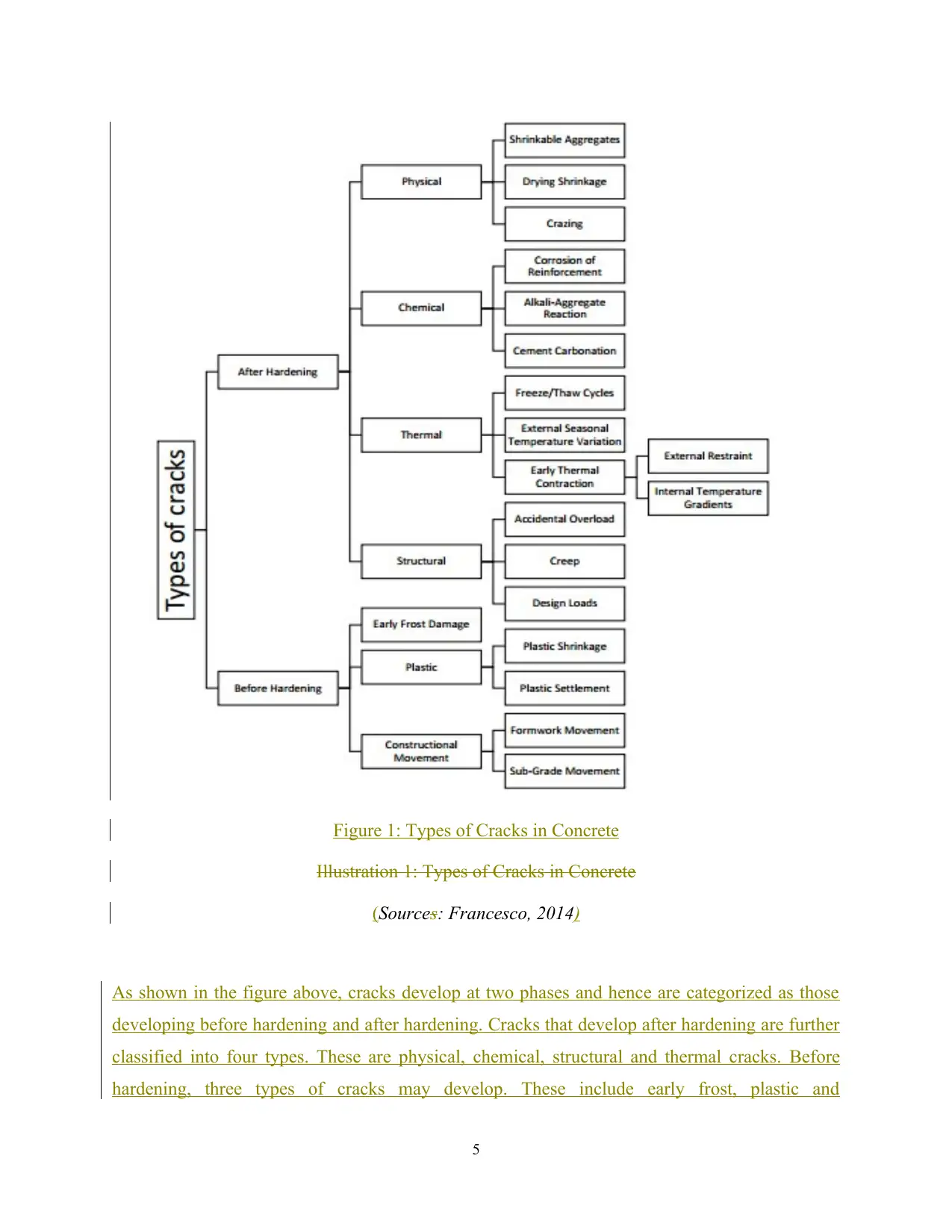
As shown in the figure above, cracks develop at two phases and hence are categorized as those
developing before hardening and after hardening. Cracks that develop after hardening are further
classified into four types. These are physical, chemical, structural and thermal cracks. Before
hardening, three types of cracks may develop. These include early frost, plastic and
5
Figure 1: Types of Cracks in Concrete
Illustration 1: Types of Cracks in Concrete
(Sources: Francesco, 2014)
developing before hardening and after hardening. Cracks that develop after hardening are further
classified into four types. These are physical, chemical, structural and thermal cracks. Before
hardening, three types of cracks may develop. These include early frost, plastic and
5
Figure 1: Types of Cracks in Concrete
Illustration 1: Types of Cracks in Concrete
(Sources: Francesco, 2014)
Paraphrase This Document
Need a fresh take? Get an instant paraphrase of this document with our AI Paraphraser
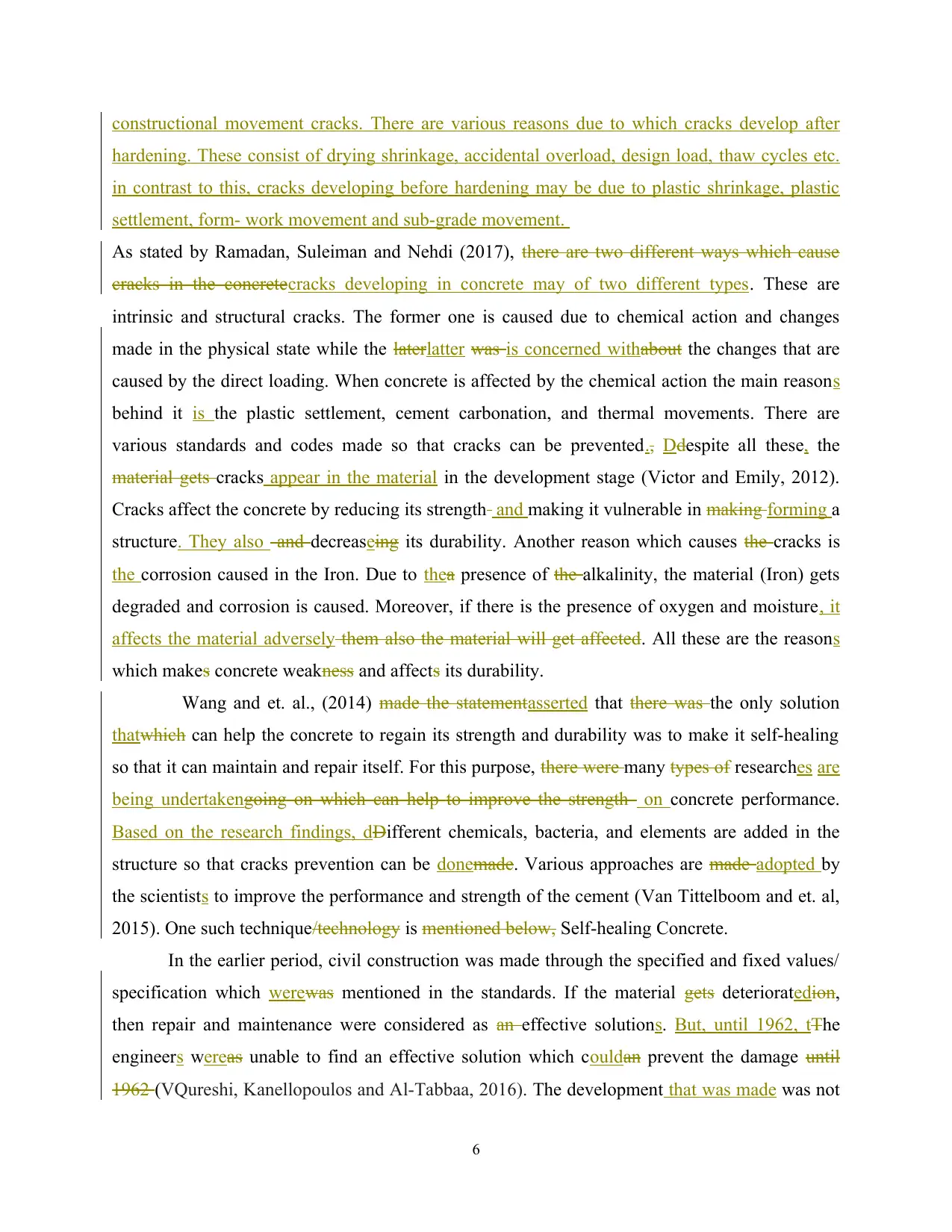
constructional movement cracks. There are various reasons due to which cracks develop after
hardening. These consist of drying shrinkage, accidental overload, design load, thaw cycles etc.
in contrast to this, cracks developing before hardening may be due to plastic shrinkage, plastic
settlement, form- work movement and sub-grade movement.
As stated by Ramadan, Suleiman and Nehdi (2017), there are two different ways which cause
cracks in the concretecracks developing in concrete may of two different types. These are
intrinsic and structural cracks. The former one is caused due to chemical action and changes
made in the physical state while the laterlatter was is concerned withabout the changes that are
caused by the direct loading. When concrete is affected by the chemical action the main reasons
behind it is the plastic settlement, cement carbonation, and thermal movements. There are
various standards and codes made so that cracks can be prevented., Ddespite all these, the
material gets cracks appear in the material in the development stage (Victor and Emily, 2012).
Cracks affect the concrete by reducing its strength and making it vulnerable in making forming a
structure. They also and decreaseing its durability. Another reason which causes the cracks is
the corrosion caused in the Iron. Due to thea presence of the alkalinity, the material (Iron) gets
degraded and corrosion is caused. Moreover, if there is the presence of oxygen and moisture, it
affects the material adversely them also the material will get affected. All these are the reasons
which makes concrete weakness and affects its durability.
Wang and et. al., (2014) made the statementasserted that there was the only solution
thatwhich can help the concrete to regain its strength and durability was to make it self-healing
so that it can maintain and repair itself. For this purpose, there were many types of researches are
being undertakengoing on which can help to improve the strength on concrete performance.
Based on the research findings, dDifferent chemicals, bacteria, and elements are added in the
structure so that cracks prevention can be donemade. Various approaches are made adopted by
the scientists to improve the performance and strength of the cement (Van Tittelboom and et. al,
2015). One such technique/technology is mentioned below, Self-healing Concrete.
In the earlier period, civil construction was made through the specified and fixed values/
specification which werewas mentioned in the standards. If the material gets deterioratedion,
then repair and maintenance were considered as an effective solutions. But, until 1962, tThe
engineers wereas unable to find an effective solution which couldan prevent the damage until
1962 (VQureshi, Kanellopoulos and Al-Tabbaa, 2016). The development that was made was not
6
hardening. These consist of drying shrinkage, accidental overload, design load, thaw cycles etc.
in contrast to this, cracks developing before hardening may be due to plastic shrinkage, plastic
settlement, form- work movement and sub-grade movement.
As stated by Ramadan, Suleiman and Nehdi (2017), there are two different ways which cause
cracks in the concretecracks developing in concrete may of two different types. These are
intrinsic and structural cracks. The former one is caused due to chemical action and changes
made in the physical state while the laterlatter was is concerned withabout the changes that are
caused by the direct loading. When concrete is affected by the chemical action the main reasons
behind it is the plastic settlement, cement carbonation, and thermal movements. There are
various standards and codes made so that cracks can be prevented., Ddespite all these, the
material gets cracks appear in the material in the development stage (Victor and Emily, 2012).
Cracks affect the concrete by reducing its strength and making it vulnerable in making forming a
structure. They also and decreaseing its durability. Another reason which causes the cracks is
the corrosion caused in the Iron. Due to thea presence of the alkalinity, the material (Iron) gets
degraded and corrosion is caused. Moreover, if there is the presence of oxygen and moisture, it
affects the material adversely them also the material will get affected. All these are the reasons
which makes concrete weakness and affects its durability.
Wang and et. al., (2014) made the statementasserted that there was the only solution
thatwhich can help the concrete to regain its strength and durability was to make it self-healing
so that it can maintain and repair itself. For this purpose, there were many types of researches are
being undertakengoing on which can help to improve the strength on concrete performance.
Based on the research findings, dDifferent chemicals, bacteria, and elements are added in the
structure so that cracks prevention can be donemade. Various approaches are made adopted by
the scientists to improve the performance and strength of the cement (Van Tittelboom and et. al,
2015). One such technique/technology is mentioned below, Self-healing Concrete.
In the earlier period, civil construction was made through the specified and fixed values/
specification which werewas mentioned in the standards. If the material gets deterioratedion,
then repair and maintenance were considered as an effective solutions. But, until 1962, tThe
engineers wereas unable to find an effective solution which couldan prevent the damage until
1962 (VQureshi, Kanellopoulos and Al-Tabbaa, 2016). The development that was made was not
6
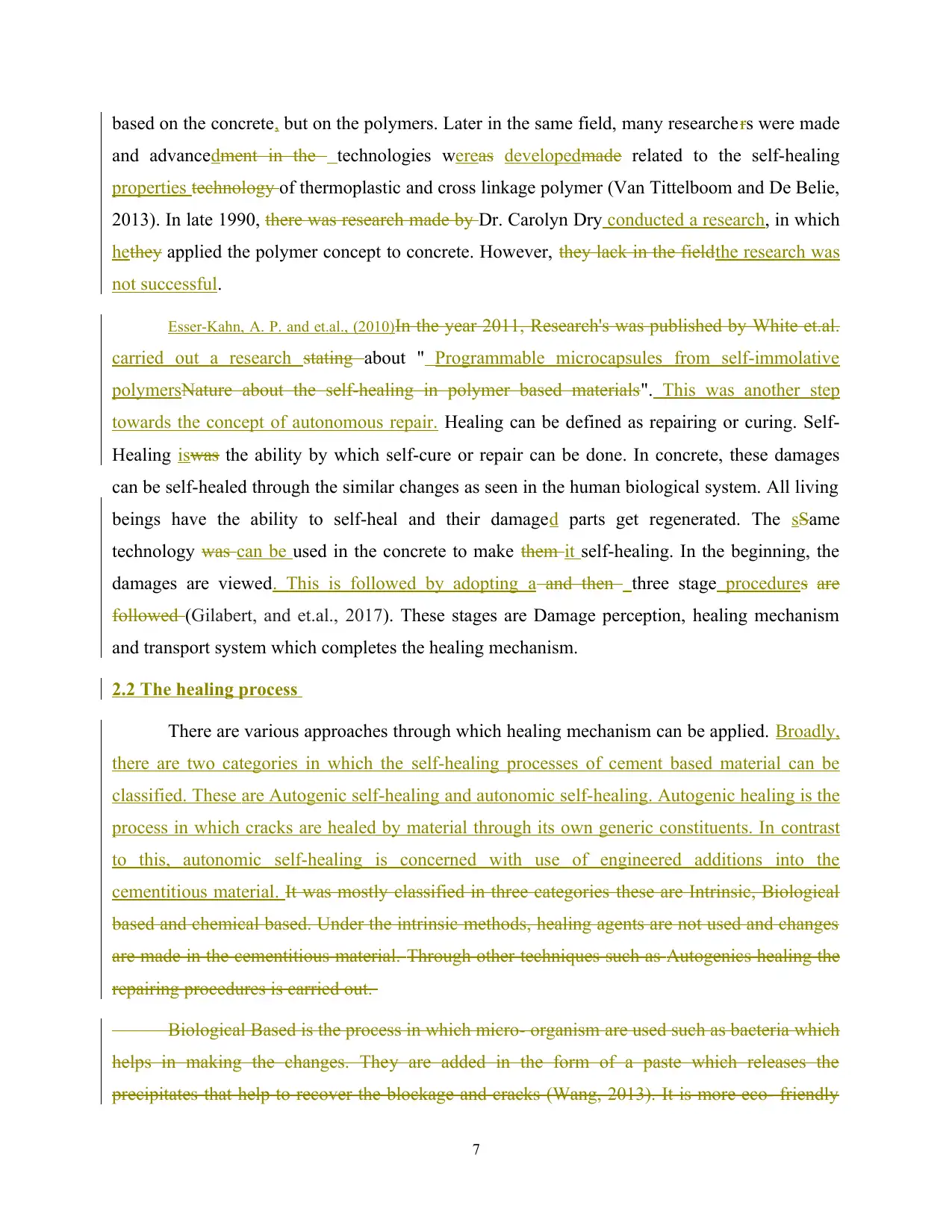
based on the concrete, but on the polymers. Later in the same field, many researchers were made
and advancedment in the technologies wereas developedmade related to the self-healing
properties technology of thermoplastic and cross linkage polymer (Van Tittelboom and De Belie,
2013). In late 1990, there was research made by Dr. Carolyn Dry conducted a research, in which
hethey applied the polymer concept to concrete. However, they lack in the fieldthe research was
not successful.
Esser-Kahn, A. P. and et.al., (2010)In the year 2011, Research's was published by White et.al.
carried out a research stating about " Programmable microcapsules from self-immolative
polymersNature about the self-healing in polymer based materials". This was another step
towards the concept of autonomous repair. Healing can be defined as repairing or curing. Self-
Healing iswas the ability by which self-cure or repair can be done. In concrete, these damages
can be self-healed through the similar changes as seen in the human biological system. All living
beings have the ability to self-heal and their damaged parts get regenerated. The sSame
technology was can be used in the concrete to make them it self-healing. In the beginning, the
damages are viewed. This is followed by adopting a and then three stage procedures are
followed (Gilabert, and et.al., 2017). These stages are Damage perception, healing mechanism
and transport system which completes the healing mechanism.
2.2 The healing process
There are various approaches through which healing mechanism can be applied. Broadly,
there are two categories in which the self-healing processes of cement based material can be
classified. These are Autogenic self-healing and autonomic self-healing. Autogenic healing is the
process in which cracks are healed by material through its own generic constituents. In contrast
to this, autonomic self-healing is concerned with use of engineered additions into the
cementitious material. It was mostly classified in three categories these are Intrinsic, Biological
based and chemical based. Under the intrinsic methods, healing agents are not used and changes
are made in the cementitious material. Through other techniques such as Autogenics healing the
repairing procedures is carried out.
Biological Based is the process in which micro- organism are used such as bacteria which
helps in making the changes. They are added in the form of a paste which releases the
precipitates that help to recover the blockage and cracks (Wang, 2013). It is more eco- friendly
7
and advancedment in the technologies wereas developedmade related to the self-healing
properties technology of thermoplastic and cross linkage polymer (Van Tittelboom and De Belie,
2013). In late 1990, there was research made by Dr. Carolyn Dry conducted a research, in which
hethey applied the polymer concept to concrete. However, they lack in the fieldthe research was
not successful.
Esser-Kahn, A. P. and et.al., (2010)In the year 2011, Research's was published by White et.al.
carried out a research stating about " Programmable microcapsules from self-immolative
polymersNature about the self-healing in polymer based materials". This was another step
towards the concept of autonomous repair. Healing can be defined as repairing or curing. Self-
Healing iswas the ability by which self-cure or repair can be done. In concrete, these damages
can be self-healed through the similar changes as seen in the human biological system. All living
beings have the ability to self-heal and their damaged parts get regenerated. The sSame
technology was can be used in the concrete to make them it self-healing. In the beginning, the
damages are viewed. This is followed by adopting a and then three stage procedures are
followed (Gilabert, and et.al., 2017). These stages are Damage perception, healing mechanism
and transport system which completes the healing mechanism.
2.2 The healing process
There are various approaches through which healing mechanism can be applied. Broadly,
there are two categories in which the self-healing processes of cement based material can be
classified. These are Autogenic self-healing and autonomic self-healing. Autogenic healing is the
process in which cracks are healed by material through its own generic constituents. In contrast
to this, autonomic self-healing is concerned with use of engineered additions into the
cementitious material. It was mostly classified in three categories these are Intrinsic, Biological
based and chemical based. Under the intrinsic methods, healing agents are not used and changes
are made in the cementitious material. Through other techniques such as Autogenics healing the
repairing procedures is carried out.
Biological Based is the process in which micro- organism are used such as bacteria which
helps in making the changes. They are added in the form of a paste which releases the
precipitates that help to recover the blockage and cracks (Wang, 2013). It is more eco- friendly
7
⊘ This is a preview!⊘
Do you want full access?
Subscribe today to unlock all pages.

Trusted by 1+ million students worldwide
1 out of 47
Related Documents
Your All-in-One AI-Powered Toolkit for Academic Success.
+13062052269
info@desklib.com
Available 24*7 on WhatsApp / Email
![[object Object]](/_next/static/media/star-bottom.7253800d.svg)
Unlock your academic potential
Copyright © 2020–2025 A2Z Services. All Rights Reserved. Developed and managed by ZUCOL.





